
April 8-21 - Louisiana
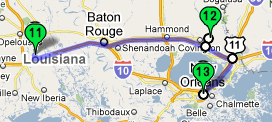 We've not been to Louisiana since we started motorhoming, but we've always liked New Orleans. We were stranded in New Orleans on 9/11/2001 when all the planes were grounded. And when Katrina struck, we were kind of afraid that the city we loved wouldn't be as we remembered. Back in November when it looked like we'd be able to spend the spring and part of summer in places we'd not been, we went on-line and requested tourist
information from several states, including Louisiana. Louisiana didn't send us anything, so we kind of planned our trip on our own, and we included New Orleans. With better planning, we'd probably have planned a little differently and also visited some other parts of the state. We like Louisiana. There's a wonderful attitude, spectacular food, friendly people, and it's the home state of Timothy Picou. That's all good. We've not been to Louisiana since we started motorhoming, but we've always liked New Orleans. We were stranded in New Orleans on 9/11/2001 when all the planes were grounded. And when Katrina struck, we were kind of afraid that the city we loved wouldn't be as we remembered. Back in November when it looked like we'd be able to spend the spring and part of summer in places we'd not been, we went on-line and requested tourist
information from several states, including Louisiana. Louisiana didn't send us anything, so we kind of planned our trip on our own, and we included New Orleans. With better planning, we'd probably have planned a little differently and also visited some other parts of the state. We like Louisiana. There's a wonderful attitude, spectacular food, friendly people, and it's the home state of Timothy Picou. That's all good.
We crossed into Louisiana and spent our first night at an interesting RV park called Poché's Fish-n-Camp at Breaux Bridge, LA (11). The RV park has five fishing ponds surrounded by RV sites. Pretty laid back, and pretty inexpensive. Had we known we'd be just 45 miles from Avery Island, we'd have spent two nights and gone down to the home of Tabasco. Alas, their hours didn't mesh with ours. Breaux Bridge is the self-proclaimed crawfish capitol of the world, and they were getting ready for the annual
Crawfish Festival, a really big deal thereabouts. But we moved on the next morning.
Anita Springs (12) was a summer retreat for New Orleans back in the day, with people leaving New Orleans to escape the summer heat and humidity. Today it's a rather quaint small town near Covington with the delightful Anita Springs RV Resort. We have reciprocal membership access, so we could stay there free, always a good price.
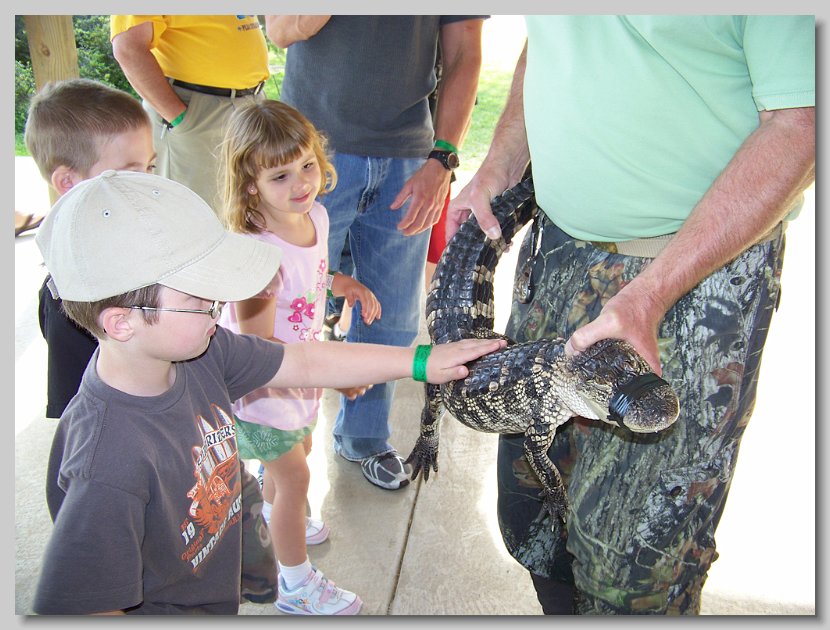 We did a lot of touristing from our base at Abita Springs. We toured the Insta-Gator Alligator Ranch, just a few miles up the road, where alligators are commercially grown. We learned the difference between an alligator ranch and an alligator farm (ranches gather wild eggs to hatch, farms breed their own gators), and had a chance to feed and touch some gators. We learned that the most popular size to harvest a gator
is around 4ft, because that's when the scale pattern is optimum for the primary use of alligator hide - watch bands. We learned that the gator farming and ranching business has been responsible for bringing back Louisiana's wild gator population from about 150,000 in the late 60s to around 7 million today (12% of all gators raised in farms and ranches must be released into the wild). Most interesting afternoon. We did a lot of touristing from our base at Abita Springs. We toured the Insta-Gator Alligator Ranch, just a few miles up the road, where alligators are commercially grown. We learned the difference between an alligator ranch and an alligator farm (ranches gather wild eggs to hatch, farms breed their own gators), and had a chance to feed and touch some gators. We learned that the most popular size to harvest a gator
is around 4ft, because that's when the scale pattern is optimum for the primary use of alligator hide - watch bands. We learned that the gator farming and ranching business has been responsible for bringing back Louisiana's wild gator population from about 150,000 in the late 60s to around 7 million today (12% of all gators raised in farms and ranches must be released into the wild). Most interesting afternoon.
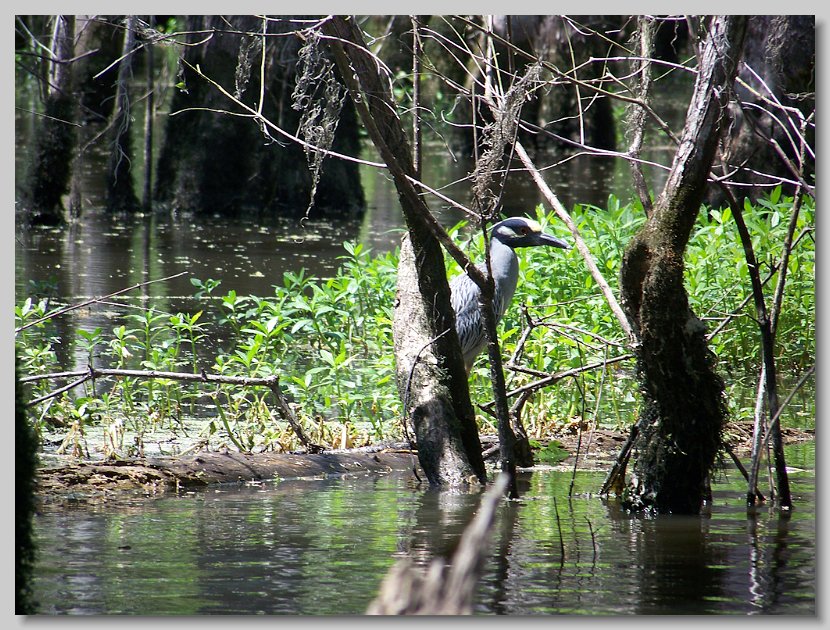 We drove to Slidell and took the Honey Island Swamp Tour, spending a couple of hours poking around one of the last pristine swamps in Louisiana. We also learned the differences between a swamp, a bayou and a marsh. A swamp is a forest under water; a marsh is a grassland under water, and a bayou is a waterway through a swamp or a marsh. There's probably more to it than that, but it's easy to remember. Saw a lot of turtles,
just one alligator, and many wonderful flowers. We drove to Slidell and took the Honey Island Swamp Tour, spending a couple of hours poking around one of the last pristine swamps in Louisiana. We also learned the differences between a swamp, a bayou and a marsh. A swamp is a forest under water; a marsh is a grassland under water, and a bayou is a waterway through a swamp or a marsh. There's probably more to it than that, but it's easy to remember. Saw a lot of turtles,
just one alligator, and many wonderful flowers.
We drove a few miles to the small town of Folsum to tour the Global Wildlife Preserve, billed as a place to see thousands of endangered, free-roaming animals. Turns out you get to tour around in a wagon, feeding all these animals with food they sell you. Pretty messy, kind of fun, but not what we expected. One day, just because, we paid our $3 toll and drove across the Lake Ponchartrain bridge into New Orleans. The bridge, at 42 miles, is the longest over-water bridge in the country. It's also a really, really
boring drive. But we did scout the route to our next destination and get some beignets at the Cafe Du Monde at Jackson Square. Yum.
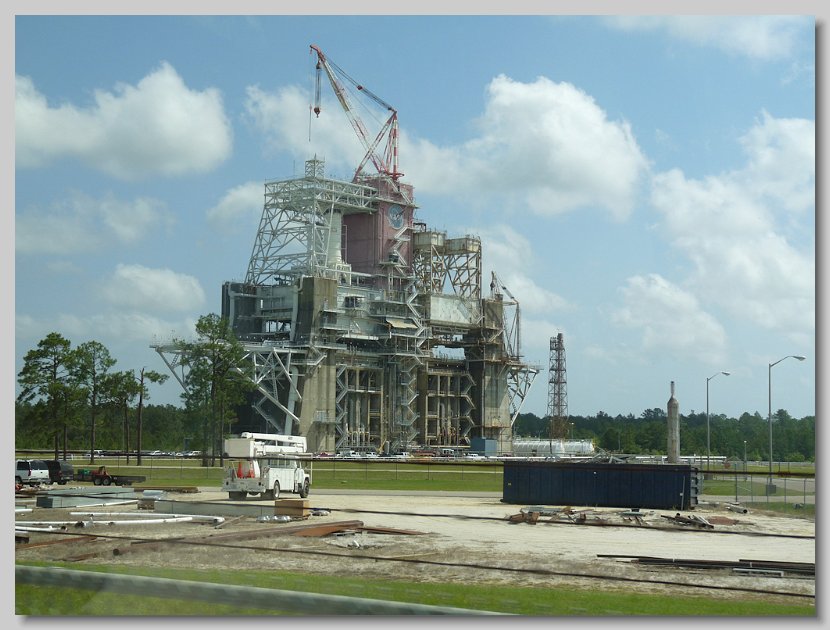 About 30 miles east, just across the Mississippi state line, is NASA's John C Stennis Space Center. It's a huge place, mostly buffer zone, where NASA tested all of the rocket engines that have powered the US rockets and space craft, including the Space Shuttle. It was said that in order to get man on the moon, first you had to go through Mississippi. There's not much rocket testing these days, and the future of the
installation is questionable given the uncertain directions of the US Space Program, but it's still an interesting place. NASA has 10 facilities in the US, and we've now toured five of them. We'll pick up a sixth in Alabama in a few weeks. About 30 miles east, just across the Mississippi state line, is NASA's John C Stennis Space Center. It's a huge place, mostly buffer zone, where NASA tested all of the rocket engines that have powered the US rockets and space craft, including the Space Shuttle. It was said that in order to get man on the moon, first you had to go through Mississippi. There's not much rocket testing these days, and the future of the
installation is questionable given the uncertain directions of the US Space Program, but it's still an interesting place. NASA has 10 facilities in the US, and we've now toured five of them. We'll pick up a sixth in Alabama in a few weeks.
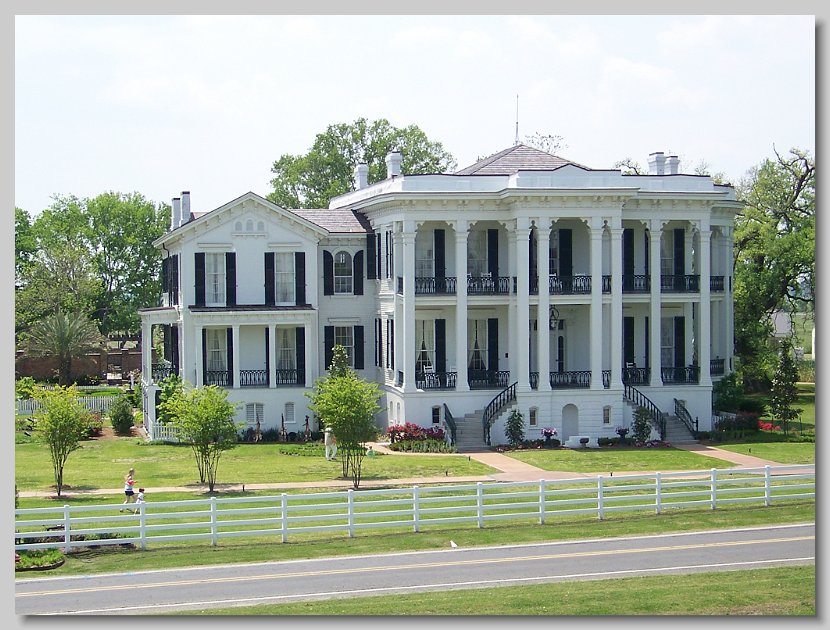 And on our last day at Abita Springs, we drove about 60 miles west to Baton Rouge to tour some plantation houses. Nottaway Plantation is the largest antebellum plantation home in the country (64 rooms) and has been lovingly restored. It operates today as a hotel, restaurant and party gathering. When we were there, there was at least one wedding happening, as well as a company picnic. We also toured the Magnolia Mound
plantation, located within Baton Rouge. As a county park, it wasn't as well funded as Nottaway, but was still interesting. And on our way home, we made a spur of the moment stop at the studio and gallery of Henry Neubig to see Louisiana Mud Paintings. To our delight, the artist himself greeted us, and we spent a most enjoyable 3/4 of an hour. Mr Neubig makes his own paints from minerals found in the mud of Louisiana, and that fact has drawn a lot of attention
to his work. He's a very talented (and very prolific) artist with the gimmick of making art by "pushing dirt around", as he says. His paints are made from the minerals he digs himself, mixed with water and egg whites. Neat guy. And on our last day at Abita Springs, we drove about 60 miles west to Baton Rouge to tour some plantation houses. Nottaway Plantation is the largest antebellum plantation home in the country (64 rooms) and has been lovingly restored. It operates today as a hotel, restaurant and party gathering. When we were there, there was at least one wedding happening, as well as a company picnic. We also toured the Magnolia Mound
plantation, located within Baton Rouge. As a county park, it wasn't as well funded as Nottaway, but was still interesting. And on our way home, we made a spur of the moment stop at the studio and gallery of Henry Neubig to see Louisiana Mud Paintings. To our delight, the artist himself greeted us, and we spent a most enjoyable 3/4 of an hour. Mr Neubig makes his own paints from minerals found in the mud of Louisiana, and that fact has drawn a lot of attention
to his work. He's a very talented (and very prolific) artist with the gimmick of making art by "pushing dirt around", as he says. His paints are made from the minerals he digs himself, mixed with water and egg whites. Neat guy.
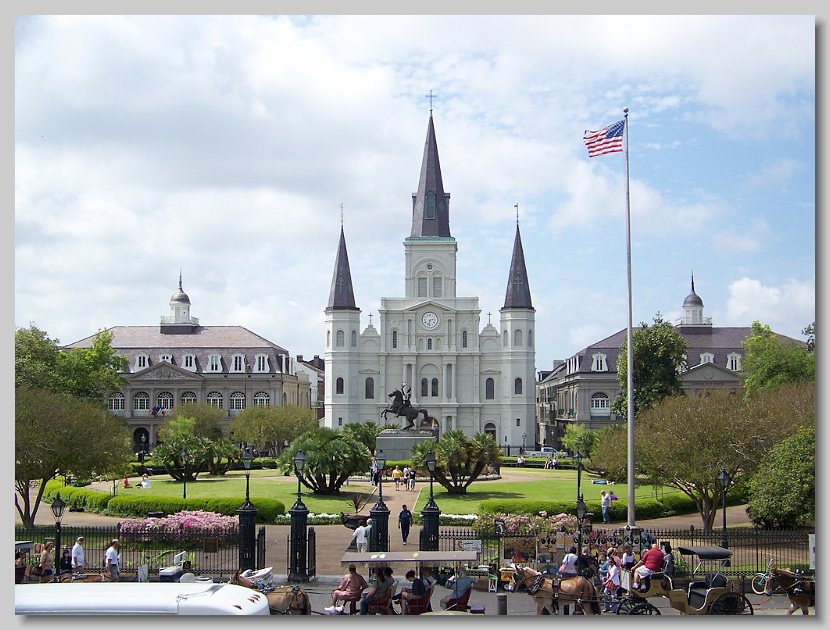 On Sunday 4/18 we drove about 55 miles around lake Ponchartrain to the French Quarter RV Resort (13) in New Orleans. Urban RV parks are a whole different experience, and the FQRV Resort is the most urban we've been in. We sometimes have to move our rig to get our satellite dish out from under a tree so we can get TV. Here, we had to move out from under a huge billboard. But it's all about location, and we were
just a few blocks from the tourist areas of the French Quarter, and less than a mile from the Mississippi River. Most expensive parking place we'll probably ever have. New Orleans is everything we remembered, and then some. We've been to most all of the major sites in New Orleans, so this trip was more about revisiting some of our favorite places. On Sunday 4/18 we drove about 55 miles around lake Ponchartrain to the French Quarter RV Resort (13) in New Orleans. Urban RV parks are a whole different experience, and the FQRV Resort is the most urban we've been in. We sometimes have to move our rig to get our satellite dish out from under a tree so we can get TV. Here, we had to move out from under a huge billboard. But it's all about location, and we were
just a few blocks from the tourist areas of the French Quarter, and less than a mile from the Mississippi River. Most expensive parking place we'll probably ever have. New Orleans is everything we remembered, and then some. We've been to most all of the major sites in New Orleans, so this trip was more about revisiting some of our favorite places.
Soon as we could, we walked to the river front. We noticed a lot of people in Spandex limping around. It wasn't until much later that we learned we'd arrived during the Ironman competition - and these folks had finished a race that involved swimming 1.2 miles in Lake Ponchartrain, riding a bike 56 miles, and then running 13.1 miles, ending up in Jackson Square. No wonder they were limping.
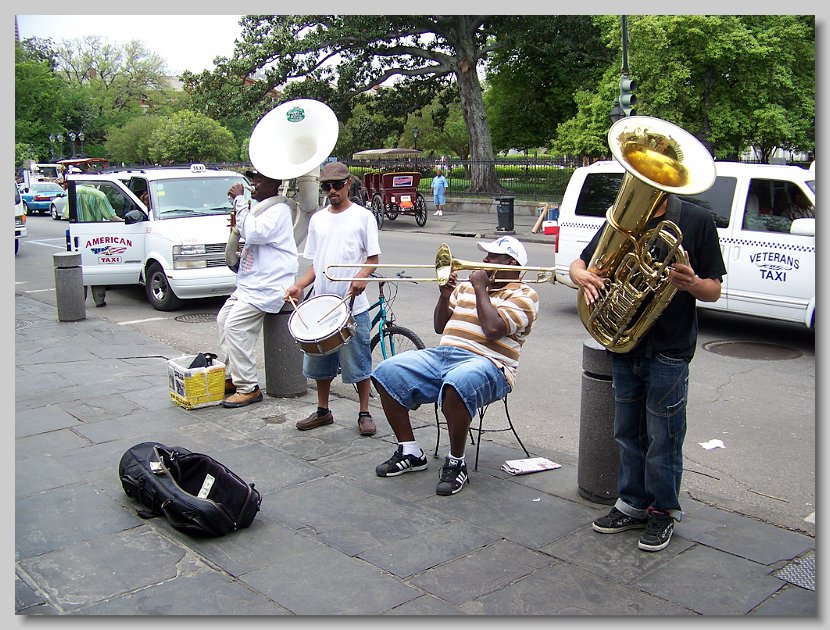 Over the next couple of days, we wandered the French Quarter, eating way too much wonderful stuff. We toured Mardi Gras World, the place where most of the Mardi Gras parade floats are made. (FYI: Next year, Fat Tuesday, the culmination of Mardi Gras and one of the largest parties on earth, is on March 16. St Patrick's Day, traditionally the second-largest party in New Orleans, is March 17. Talk about a double
whammy - it'll be the biggest party of the century.) We sat on a bench on the Moonwalk and watched the river and the people go by. We had an extravagant dinner at Emeril Lagasse's NOLA, where we were taken to the same table we'd dined at in 2001, and where the food, service and ambiance were every bit as exceptional as we remembered. One night, we heard a large "boom" and went outside the motor home to watch one of the nicest fireworks displays we've seen. Never did find out what the occasion was,
but it was obviously down on the riverfront, and it went on for about 20 minutes. We like New Orleans. It's not cheap, but it sure is a neat place. We wore our widdle selves out. Over the next couple of days, we wandered the French Quarter, eating way too much wonderful stuff. We toured Mardi Gras World, the place where most of the Mardi Gras parade floats are made. (FYI: Next year, Fat Tuesday, the culmination of Mardi Gras and one of the largest parties on earth, is on March 16. St Patrick's Day, traditionally the second-largest party in New Orleans, is March 17. Talk about a double
whammy - it'll be the biggest party of the century.) We sat on a bench on the Moonwalk and watched the river and the people go by. We had an extravagant dinner at Emeril Lagasse's NOLA, where we were taken to the same table we'd dined at in 2001, and where the food, service and ambiance were every bit as exceptional as we remembered. One night, we heard a large "boom" and went outside the motor home to watch one of the nicest fireworks displays we've seen. Never did find out what the occasion was,
but it was obviously down on the riverfront, and it went on for about 20 minutes. We like New Orleans. It's not cheap, but it sure is a neat place. We wore our widdle selves out.
On Wednesday morning 4/21 we hooked up and headed east, across Mississippi and into Alabama. New adventures await.
See some of the pictures we did take during our 13 days in Louisiana here.
|

 We've not been to Louisiana since we started motorhoming, but we've always liked New Orleans. We were stranded in New Orleans on 9/11/2001 when all the planes were grounded. And when Katrina struck, we were kind of afraid that the city we loved wouldn't be as we remembered. Back in November when it looked like we'd be able to spend the spring and part of summer in places we'd not been, we went on-line and requested tourist
information from several states, including Louisiana. Louisiana didn't send us anything, so we kind of planned our trip on our own, and we included New Orleans. With better planning, we'd probably have planned a little differently and also visited some other parts of the state. We like Louisiana. There's a wonderful attitude, spectacular food, friendly people, and it's the home state of Timothy Picou. That's all good.
We've not been to Louisiana since we started motorhoming, but we've always liked New Orleans. We were stranded in New Orleans on 9/11/2001 when all the planes were grounded. And when Katrina struck, we were kind of afraid that the city we loved wouldn't be as we remembered. Back in November when it looked like we'd be able to spend the spring and part of summer in places we'd not been, we went on-line and requested tourist
information from several states, including Louisiana. Louisiana didn't send us anything, so we kind of planned our trip on our own, and we included New Orleans. With better planning, we'd probably have planned a little differently and also visited some other parts of the state. We like Louisiana. There's a wonderful attitude, spectacular food, friendly people, and it's the home state of Timothy Picou. That's all good.